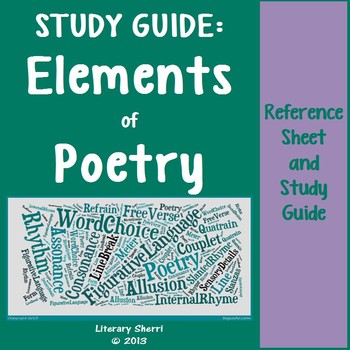POETRY: Elements of Poetry Reference Sheet, Study Guide, and Review
- PDF
What educators are saying
Description
Use this Elements of Poetry Study Guide for clear, consistent review of poetic elements and devices, to enable close reading of poetry, or to facilitate common language about poetic elements between classrooms and grade levels.
Make 2-sided copies on card stock, laminate, attach with a brad in the upper left corner, and distribute one study guide to each student.
THIS ELEMENTS OF POETRY RESOURCE INCLUDES:
- Reference information for each of the following poetic elements, arranged in alphabetical order so students can quickly and easily find what they need:
- allusion, assonance, consonance, couplet, figurative language, form, free verse, internal rhyme, line, line break, meter, quatrain, refrain, rhyme, slanted rhyme, rhyme scheme, rhythm, sensory details, sound devices, stanzas, traditional poems, word choice
- Examples from T.S. Eliot, Emily Dickinson, Alfred Noyes, Carl Sandburg, Edgar Allen Poe, Wallace Stevens, Maya Angelou, William Wordsworth, William Blake, Langston Hughes, Dylan Thomas, Robert Burns, Shakespeare, and others.
- "Anatomy of a Poem" . . . a "dissection" of a poem to show how poets combines a variety of techniques
- to create meaningful and memorable word pictures that communicate emotions and ideas.
- Learning Objectives, Common Core State Standards, and Terms of Use
LET'S CONNECT:
- Follow Literary Sherri on TpT
- Newsletter with Exclusive Freebies
- Literary Sherri Blog
- FB Community for 6-12 ELA Teachers
THANK YOU FOR YOUR FEEDBACK!
If you find this resource useful for your students, please help other teachers find it, also, by leaving feedback.
If this resource can be revised to better meet your students' needs, please reach out to me via my email or Q&A tab.
GET TpT CREDIT TO USE ON FUTURE PURCHASES:
- Go to your My Purchases page.
- Click 'Provide Feedback' to leave a rating and a short comment.
- Earn TpT credits to redeem on future purchases!
I'm over-the-moon happy to create resources for you and your students! Thank you for stopping by.
Questions? Please email: literarysherri@literarysherri.org
© Literary Sherri www.literarysherri.com





